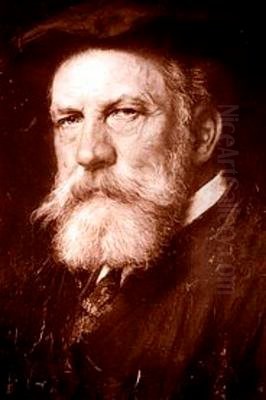
Adolf Schreyer stands as a significant figure in 19th-century German art, renowned primarily for his dynamic and evocative depictions of horses, Bedouin life, and dramatic battle scenes. Born in Frankfurt am Main in 1828 and passing away in Cronberg im Taunus in 1899, Schreyer's life and art were deeply intertwined with his extensive travels, particularly through Eastern Europe, North Africa, and the Middle East. His work captures the spirit of Orientalism, a fascination with the cultures and landscapes of the East that swept through European art during his time, yet he brought a distinct Germanic intensity and technical prowess to his subjects.
Early Life and Artistic Formation
Christian Adolf Schreyer entered the world in Frankfurt am Main, a city with a growing artistic consciousness. His initial artistic training took place at the prestigious Städel Institute in his hometown, laying a solid foundation in drawing and painting. Eager to broaden his horizons and refine his skills, Schreyer continued his studies in other major German art centers. He spent time in Stuttgart, Munich, and Düsseldorf, absorbing the diverse artistic currents flowing through these cities.
The Düsseldorf Academy, in particular, was a powerhouse of German art education in the mid-19th century, known for its emphasis on detailed realism and narrative painting, often with historical or landscape themes. While Schreyer may not have formally enrolled for an extended period or become a core member of the "Düsseldorf School" in the strictest sense, exposure to its methods and the work of artists associated with it, such as the landscape masters Andreas Achenbach and Oswald Achenbach, would have undoubtedly contributed to his technical development and understanding of dramatic composition. His education provided him with the technical facility necessary to capture the complex subjects that would later define his career.
The Call of the East: Travels and Experiences
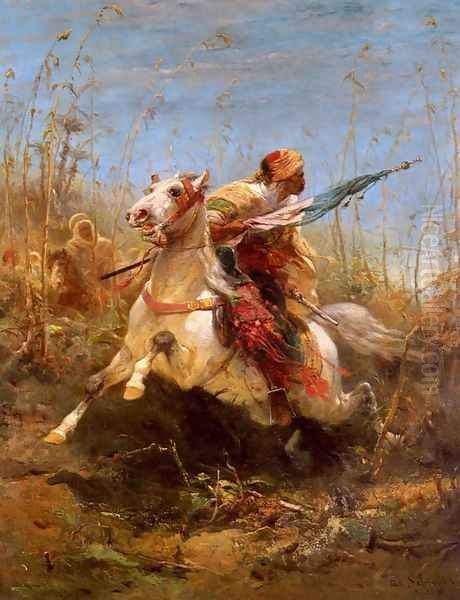
A defining characteristic of Schreyer's life and art was his wanderlust and thirst for firsthand experience. Unlike artists who relied solely on studio props and imagination, Schreyer sought out the environments he wished to paint. His travels began significantly when he accompanied Prince Emmerich von Thurn und Taxis on journeys through Hungary, Wallachia (a historical region of Romania), Southern Russia, and Turkey. These early expeditions exposed him to diverse cultures, landscapes, and, crucially, the horses and horsemen that would become central motifs in his work.
His adventurous spirit led him further afield. In 1854, during the Crimean War, Schreyer demonstrated both patriotism and artistic dedication by joining the Austrian army as it crossed the Wallachian border. Some sources suggest he served as an official war artist during parts of the conflict (1854-1856), an experience that would have provided him with intense, direct exposure to military life, the chaos of battle, and the rugged conditions faced by soldiers and their steeds. This period undoubtedly fueled his interest in depicting dramatic, action-filled scenes.
Following the war, Schreyer's focus shifted more decisively towards the Near East and North Africa. In 1856, he embarked on a pivotal journey to Egypt and Syria. This immersion in the heart of the Arab world was transformative. He was captivated by the desert landscapes, the vibrant culture, and the proud Bedouin tribesmen with their magnificent Arabian horses. He reportedly even took the time to learn Arabic, demonstrating a deeper commitment to understanding the culture than many of his Orientalist contemporaries.
His North African explorations continued in 1861 with a trip to Algeria. This region, already a popular subject for French Orientalist painters like Eugène Delacroix and Eugène Fromentin, offered Schreyer further opportunities to study the interplay of light on desert sands, the architecture, and the daily life of its inhabitants. These travels were not mere sightseeing tours; they were fundamental research expeditions that provided the authentic details, atmosphere, and emotional intensity that permeate his best paintings.
Artistic Style and Themes
Adolf Schreyer's artistic output is overwhelmingly characterized by Orientalist themes, with a particular focus on horses and Arab or Bedouin figures. He developed a distinctive style marked by vigorous brushwork, a rich color palette, and a masterful handling of light and shadow to create dramatic effects. His paintings often convey a sense of energy, movement, and raw emotion, whether depicting a cavalry charge, a solitary rider in the vast desert, or horses struggling against the elements.
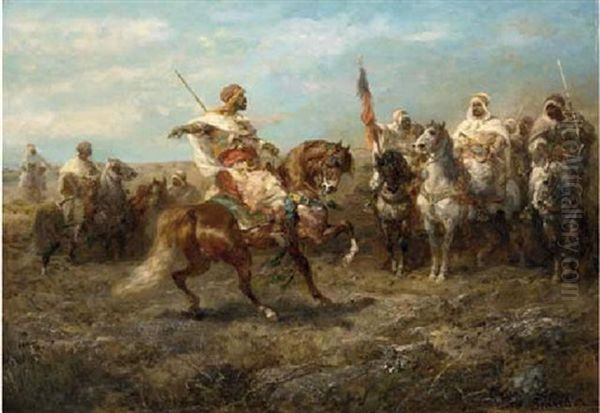
His portrayal of horses is particularly noteworthy. Schreyer possessed an exceptional understanding of equine anatomy and movement, capturing the power, grace, and spirit of the animals with remarkable accuracy and empathy. His horses are not mere accessories but central actors in his narratives, often shown in moments of high tension or exertion. The Arabian horse, prized for its beauty and endurance, features prominently, rendered with an appreciation for its specific characteristics.
Schreyer's approach to Orientalism shares affinities with the French Romantic tradition, particularly the work of Eugène Delacroix, who also found inspiration in North Africa and depicted dramatic scenes with vibrant color and emotional intensity. Comparisons have also been drawn with Eugène Fromentin, another French artist celebrated for his depictions of Algerian landscapes and horsemen. However, Schreyer's work often possesses a certain Northern European weight and seriousness, a slightly darker or more dramatic tone compared to the sometimes more luminous or ethnographic approach of some French counterparts like Jean-Léon Gérôme.
His technique involved applying paint in a way that suggested texture and movement, often using impasto to highlight certain areas and create a sense of immediacy. He excelled at depicting challenging atmospheric conditions – the biting wind of a snowstorm in Eastern Europe (another recurring theme, especially from his earlier travels), the shimmering heat of the desert, or the dramatic chiaroscuro of a stormy sky. This ability to evoke mood and environment through light and texture is a hallmark of his style.
Life in Paris and Later Years
Recognizing Paris as the undisputed center of the art world in the mid-19th century, Schreyer moved there in 1862. This period was crucial for establishing his international reputation. He exhibited his works regularly at the prestigious Paris Salon, the official art exhibition of the Académie des Beaux-Arts, where he gained considerable recognition and won medals for his submissions. His participation in the Exposition Universelle (World's Fair) in Paris in 1867 further cemented his status as a leading painter of Orientalist and equestrian subjects.
During his time in Paris, which lasted until 1870, Schreyer likely interacted with numerous French and international artists, absorbing the city's vibrant artistic atmosphere. His success was notable, and his paintings found favor not only with French audiences but also, significantly, with American collectors. The dramatic energy and exoticism of his work appealed greatly to the tastes of the Gilded Age elite in the United States.
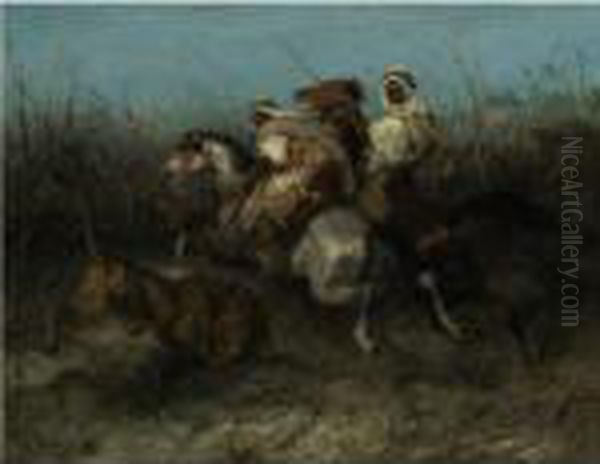
The outbreak of the Franco-Prussian War in 1870 prompted Schreyer, a German national, to leave Paris. He returned to Germany and eventually settled in Cronberg im Taunus, a picturesque town near his native Frankfurt. Cronberg was already developing into an artists' colony, attracting painters drawn to its scenic landscapes and proximity to the Frankfurt art market. Figures like Anton Burger and Jakob Fürchtegott Dielmann were associated with the colony's earlier phase. Schreyer became one of its most prominent residents, establishing his studio there and continuing to paint prolifically. He remained in Cronberg until his death in 1899 at the age of 71.
Representative Works
Several paintings stand out as representative of Adolf Schreyer's oeuvre, showcasing his key themes and stylistic strengths:
Arab Charge (or similar titles like Arabian Warriors on Horseback, Desert Charge): This is perhaps Schreyer's most iconic subject. Numerous variations exist, typically depicting a group of Bedouin warriors on horseback galloping furiously across the desert, often brandishing rifles. These works exemplify his skill in capturing dynamic movement, the energy of the horses, the flowing robes of the riders, and the dramatic, dusty atmosphere of the desert under a vast sky. The sense of urgency and controlled chaos is palpable.
Wallachian Teamsters in Snow (or similar titles depicting Eastern European winter scenes): Contrasting with his sun-drenched desert scenes, Schreyer also frequently returned to subjects inspired by his travels in Eastern Europe. These paintings often show teams of sturdy horses pulling wagons or sleds through harsh winter landscapes, battling snow and wind. They highlight his ability to render different climates and textures, the shaggy coats of the horses, the heavy snow, and the resilience of both animals and humans against the elements.
Arabian Caravan Crossing the Desert Stream: This title represents another common theme, depicting the more measured pace of desert travel. Such scenes allowed Schreyer to explore the interplay of light on water, the reflections, and the grouping of figures and animals within a wide landscape. They often convey the vastness and silence of the desert, punctuated by the presence of the caravan.
Abandoned (Algerian Battlefield): Some works carry a more somber tone, reflecting his experiences with conflict. Paintings depicting the aftermath of a battle, perhaps showing riderless horses or fallen figures, showcase a different facet of his engagement with military and Orientalist themes, touching upon the costs of conflict.
These examples illustrate the range within Schreyer's preferred subjects – from high-octane action to atmospheric landscapes and scenes of daily life or struggle, all rendered with his characteristic technical skill and dramatic flair.
Reception, Collection, and Criticism
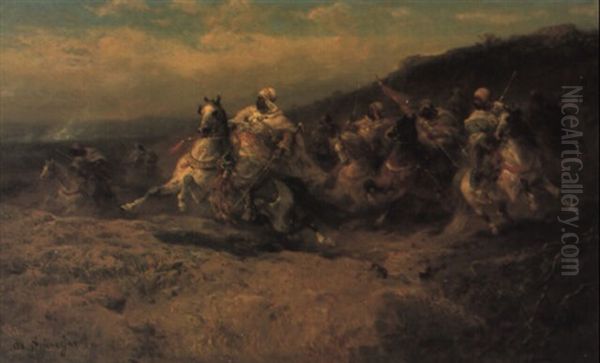
Adolf Schreyer achieved considerable fame and commercial success during his lifetime. His paintings were highly sought after by collectors across Europe and, notably, in the United States. Wealthy American patrons, including prominent families sometimes cited as the Vanderbilts and Rockefellers (though specific acquisitions require verification), were particularly drawn to the dramatic intensity and exotic appeal of his work. This American enthusiasm contributed significantly to his international renown and financial success, placing him alongside other European artists popular during the Gilded Age, such as the French academic painter William-Adolphe Bouguereau or the Spanish virtuoso Mariano Fortuny.
His success was validated by official recognition, including medals won at the Paris Salon and inclusion in major international exhibitions. Today, his works are held in the permanent collections of numerous prestigious museums worldwide, including the Metropolitan Museum of Art in New York, the Hermitage Museum in St. Petersburg, the Louvre Museum in Paris (though holdings might be limited), the National Gallery in Berlin, the Städel Museum in Frankfurt, and the Hamburger Kunsthalle, among others. This widespread institutional presence attests to his historical significance.
Despite his popularity, Schreyer's work, like much Orientalist art, has faced criticism, particularly from a post-colonial perspective. Some critics argue that his depictions, while technically brilliant and dramatically compelling, sometimes rely on romanticized or stereotypical views of Arab and Bedouin culture. The focus on fierce warriors and dramatic charges, while appealing to Western audiences seeking exoticism and adventure, could be seen as overshadowing more nuanced or realistic portrayals of daily life and complex social realities. His work might be viewed as prioritizing the picturesque and the thrilling over deeper ethnographic understanding, a criticism sometimes leveled at Orientalist painters who catered to market demands for the exotic. However, his dedication to travel and firsthand observation arguably lent his work a greater degree of authenticity than that of purely studio-bound Orientalists.
Schreyer in Context: Contemporaries and Influences
To fully appreciate Adolf Schreyer's contribution, it's helpful to place him within the broader context of 19th-century European art. He operated at a time of diverse artistic movements. In Germany, while Romanticism still held sway, Realism was gaining ground, and figures like Anselm Feuerbach pursued a form of classicism, while Arnold Böcklin explored Symbolism. Schreyer's path, focusing on internationally popular themes like Orientalism and equestrian subjects, set him somewhat apart from purely national German trends, aligning him more closely with Parisian currents.
His most direct artistic kinship lies with the French Orientalists. As mentioned, Delacroix was a key precursor in terms of romantic energy and North African subjects. Fromentin shared his interest in Algeria and horses. Jean-Léon Gérôme represented a more polished, highly detailed, and often anecdotal style of Orientalism. Schreyer carved his niche within this field through his specific focus on Arab warriors, his dynamic compositions, and his often more rugged, energetic brushwork compared to Gérôme's smooth finish.
His mastery of animal painting also connects him to other specialists in the genre, such as the celebrated French animalière Rosa Bonheur, although Schreyer almost always integrated his animals into larger narrative or landscape contexts, particularly those involving human action and drama. His depictions of Eastern European scenes also link him to a tradition of artists documenting the landscapes and peoples of that region, though his dramatic flair often set his work apart.
Schreyer successfully navigated the international art market of his time, bridging German artistic training with the subjects and exhibition platforms centered in Paris. He absorbed influences from French Romanticism and Orientalism but interpreted them through his own distinct sensibility, marked by technical solidity and a penchant for dramatic intensity.
Enduring Legacy
Adolf Schreyer remains a significant figure in 19th-century German art, primarily recognized for his contributions to Orientalist painting and his exceptional skill as an equestrian artist. His life of extensive travel provided the foundation for works that captured the imagination of audiences in Europe and America with their exotic subjects, dramatic action, and atmospheric depth. He successfully blended German artistic training with the popular themes and market demands centered in Paris, achieving widespread acclaim and securing a lasting place in major museum collections.
While contemporary perspectives may critique the inherent biases within the Orientalist genre, Schreyer's technical mastery, his ability to convey energy and emotion, and his dedication to experiencing firsthand the worlds he depicted cannot be denied. His paintings of charging Arab horsemen, struggling Wallachian teams in snow, and vast desert landscapes continue to resonate with viewers through their power and evocative quality. He stands as a testament to an era fascinated by the exotic, skilled in realistic representation, and appreciative of high drama on canvas.